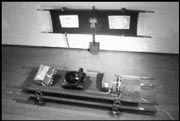NOTHING WARMS MY HEART more than a pack of grubby artists standing around, smoking cigarettes. Walking into Fuzzy Engine on the opening night of its “Look Both Ways” show, I experienced a Proustian-style flashback to college days. There I was, an eager art history student, trying to cop some kind of avant-garde attitude, venturing from the staid academic realm to mingle with those on the gritty production end of art. Walking into the murky unknown of a makeshift loft studio inhabited by a bunch of art students, you’re greeted by the smell of smoke and old beer, tempered by that delicious odor of fresh oil paint. Fuzzy Engine, in its gutted and unfinished glory, bears the same kind of thrilling, underground, and somehow illicit aura. As you weave your way through the space you do get a feeling, however, of the seriousness of this endeavor: The art is mature, and the artists are dead serious about making work that validates this new enterprise as a viable art locale in town.
Look Both Ways
Fuzzy Engine Gallery, ends January 8
This is the second show put on by the 10 artists who make up Fuzzy Engine. Spearheaded by Walter Wright and a few other artists who were part of the now-defunct Project 416, Fuzzy Engine aims to mount exhibitions that are based on a central theme generated by the group. Each member creates work in reaction to the theme, and they invite outside artists to show work in their hallways. In an emblematically stark, whitewashed gallery space at the core of the building is the members’ work. It’s here that the theme “Look Both Ways” comes together.
“Look Both Ways” addresses the question “What is safety?” Most of the answers are tongue-in-cheek, mocking the overly protective and safety-obsessed society in which we live. In Loaded, artist Steve Veatch mounts a Colt .45 in a cement block, which then points skyward in a rather obviously phallic stance. The piece is accompanied by an anecdotal text that starts off, “I once knew the man who owned this pistol.” Touching on the man’s explosive temper and conspiracy theories, it ends, “Sometimes I happened upon him drinking, dry firing the gun in his kitchen, glowering, sullen, deliberate.”
OTHER CLICHES ARE touched upon with a good sense of humor and solid conceptual and artistic vigor. Blair Wilson’s cartoonish, almost life-sized cutout of a policeman, menacingly brandishing a gun in each hand, illustrates our worst fear: the gun-toting cop gone bad. The humor thickens when you realize that this angry cop has two big blue testicles hanging at his crotch. You are invited to pull on them. Ranging from toilet paper as safety item to soft sculpture air bags and a glass motorcycle helmet by Randy McCoy, the absurdity of hypersafety is prodded until it hurts. Subtlety isn’t what Fuzzy Engine is all about; the central theme serves as a vehicle for each artist to make work that is extreme or beyond the scope of their usual production. Susan Spencer and Blair Wilson’s series of traditional Harley-Davidson-style embroidered patches called Badges to Wear Keeping You Safe and People Away is unobtrusive but quite brilliant. They read, “No Money,” “Packin’ Heat,” “I have a wife and kids,” “Violent Outburst Hazard,” and “You are being videotaped”—rather meek attempts at warding off an attacker, paradoxically fashioned in the guise of the quintessentially badass biker insignia.
Its unfinished, underground qualities give Fuzzy Engine added allure. Like an art-student’s den, the space and the concept are compelling in their transience. In a slapdash context, the art takes primacy, and commercialism falls by the wayside. Walter Wright calls it “a testament to how artists adapt to the situation,” referring to the mass exodus of artists out of the city’s center. Thankfully, the exodus is breeding projects like this one, which in turn spawn interesting, highly experimental art in a city that would otherwise allow sleepy landscapes and abstractions to suffice.








